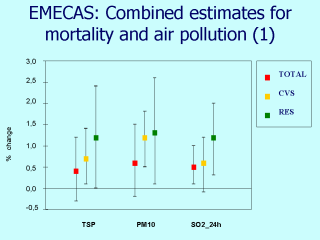| front |1 |2 |3 |4 |5 |6 |7 |8 |9 |10 |11 |12 |13 |14 |15 |16 |17 |18 |19 |20 |21 |22 |23 |24 |25 |26 |27 |28 |29 |30 |31 |32 |33 |34 |35 |review |
 |
NOTES TO THE
FIGURE: Results expressed as the estimated percentage changes in daily deaths (and the 95%CI) for an increase of 10 µg/m3 in the concentration of the pollutant levels. Lag 01. Single pollutant models Mortality for: TOTAL: All causes except external CVS: All cardiovascular diseases RESP: All respiratory causes Combined results showed a significant association between air pollution indicators and mortality. An increase of 10m g/m3 in the levels of the average of the concurrent and one day lag for black smoke was associated with a 0.8% increase in mortality (Ballester et al., 2002). The estimates for TSP and PM10 and total mortality were slightly lower. The same increase in concentrations of SO2 was associated with a 0.5% increase in daily deaths, and a 0.6% in the case of NO2. For groups of specific causes we found higher magnitude in the estimations, especially for respiratory conditions. Ozone only showed statistical significance with cardiovascular mortality (Saez, et al). When two pollutant analyses were performed, estimates for all pollutants did not substantially modify, except for SO2 where estimates for daily levels were strongly attenuated. On the contrary, the association for one-hour maximum levels of this pollutant did not show any change. |